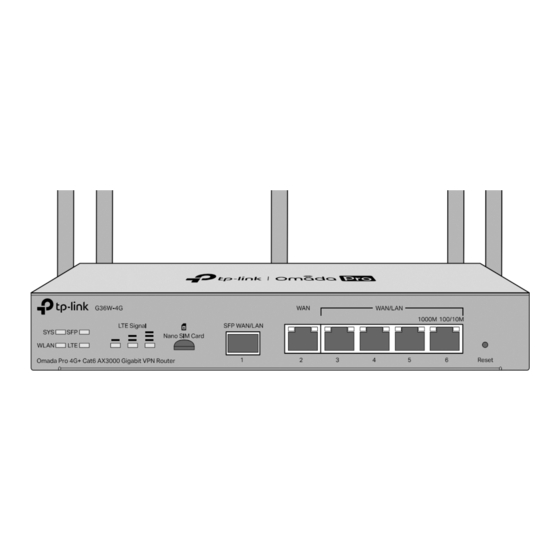
Table of Contents
Advertisement
Quick Links
Installation Guide
Omada Pro 4G+ Cat6 AX3000 Gigabit VPN Router
Note: The image may differ from the actual product.
Hardware Overview
Front Panel
LED
Reset: Press and hold the button for 5 seconds, the SYS LED will flash
quickly, indicating the device is being reset to its factory default
settings.
Interface
Description
Nano SIM Card
For Nano SIM card.
Slot
Gigabit SFP WAN/LAN port connecting to an SFP module.
By default, it is a WAN port.
SFP WAN/LAN
You can configure it to a LAN port on the management page.
WAN
Gigabit RJ45 WAN port.
Gigabit RJ45 WAN/LAN ports.
WAN/LAN
By default, they are LAN ports connecting to local PCs or switches.
(Ports 3-6)
You can configure each port to a WAN port on the management page.
Kensington
Secure the lock (not provided) into the security slot to prevent the
Security Slot
device from being stolen.
Grounding
The router comes with a lightning protection mechanism.
Terminal
Power Socket
Connect to the power outlet via the provided power adapter.
Hardware Connection
1. Attach the Wi-Fi antennas and 4G
antennas. Antennas can be distinguished
by their markings
Note: Make sure you attach the Wi-Fi antennas and 4G
antennas to the correct connectors.
2. Use the charger provided in the
package to power on the router.
3. Connect to the internet using one or multiple options.
Option 1 Connect to Internet via 4G SIM card
With the gold contacts facing
down, insert the nano SIM
card into the slot until you
hear a click.
Wait until the SYS LED flashes
slowly and the LTE Signal LED
turns solid, indicating the router is
connected to the internet.
Note: For better internet connection, make sure
Signal LED is lit. Otherwise, try relocating the router to a
spot that may receive a stronger mobile network signal,
such as near a window.
3
Software Configuration
The router supports two configuration options:
Standalone Mode: Configure and manage the router by itself.
Controller Mode: Configure and manage network devices centrally. It is recommended in large-scale networks, which consist of a large number of devices such
as access points, switches, and gateways.
Note:
1. When the router is managed by a controller, configurations of the router will be overridden by the controller.
2. For the detailed configurations, refer to the User Guide of the router and the controller. The guides can be found on the download center of our official website:
https://www.tp-link.com/support/download/.
Option 1: Standalone Mode
Wi-Fi
ANT
4G
ANT
Option 2 Connect to Internet via Ethernet
Modem
Connect to Port 2
Note: To connect to the internet via another RJ45 WAN port
or
LTE
(ports 3-6), configure your desired port to WAN, then
connect the port to the internet via an RJ45 cable. Refer to
FAQ-Q1 for more details.
Router
To ask questions, find answers, and communicate with TP-Link users or
engineers, please visit https://community.tp-link.com to join TP-Link
Community.
For technical support and other information, please visit
https://www.tp-link.com/support, or simply scan the QR code.
© 2023 TP-Link 7106510628 REV1.0.0
Back Panel
Kensington
Security Slot
Grounding Terminal
Wi-Fi
Wi-Fi
ANT
ANT
LED
Indication
Slow Flashing: System is running normally.
SYS
Quick Flashing: The router is being reset.
On/Off: System is starting up or running abnormally.
On: Wireless networking is enabled.
WLAN
Off: Wireless networking is disabled.
On: Running at 1000 Mbps, but no activity.
Off: No device is linked to the corresponding port.
SFP
Flashing: Running at 1000 Mbps, and transmitting or receiving data.
On: SIM card is connected to the mobile internet.
LTE
Off: No SIM card is inserted, or it is not connected to the mobile internet.
On: Indicates the signal strength the router received from the mobile
LTE Signal
internet. More bars indicate a better signal strength.
(3 LEDs)
Off: No mobile internet signal.
Green On: Running at 1000 Mbps, but no activity.
Green Flashing: Running at 1000 Mbps, and transmitting or receiving data.
Link/Act
Green Off: Not running at 1000 Mbps, or no device is connected to the
corresponding port.
Green
Yellow On: Running at 100/10 Mbps, but no activity.
Yellow Flashing: Running at 100/10 Mbps, and transmitting or receiving data.
Yellow
Yellow Off: Not running at 100/10 Mbps, or no device is connected to
the corresponding port.
Wi-Fi
Wi-Fi
ANT
ANT
Option 3 Connect to Internet via Fiber
Connect to SFP WAN Slot
SFP Module
Wireless Internet Connection
Wired Internet Connection
Power Socket
12V
2.0A
Wi-Fi
ANT
4G
ANT
Fiber-Optic Cable
Advertisement
Table of Contents

Summary of Contents for TP-Link Omada Pro 4G+
- Page 1 Installation Guide Omada Pro 4G+ Cat6 AX3000 Gigabit VPN Router To ask questions, find answers, and communicate with TP-Link users or engineers, please visit https://community.tp-link.com to join TP-Link Community. Note: The image may differ from the actual product. For technical support and other information, please visit https://www.tp-link.com/support, or simply scan the QR code.
- Page 2 Note: For the cloud-based controller, skip step 2. 1. Make sure that Cloud Access is enabled on your controller and your 3. Launch the Omada app and log in with your TP-Link ID. Then go to controller has been bound with your TP-Link ID.










Need help?
Do you have a question about the Omada Pro 4G+ and is the answer not in the manual?
Questions and answers